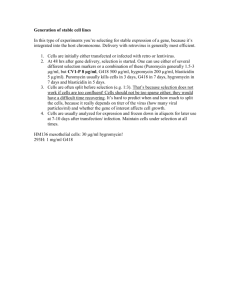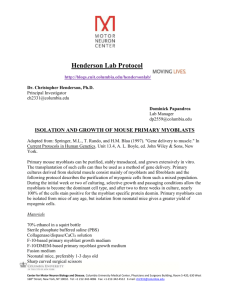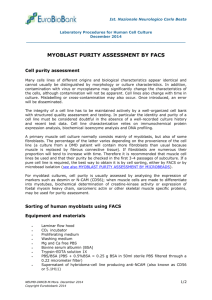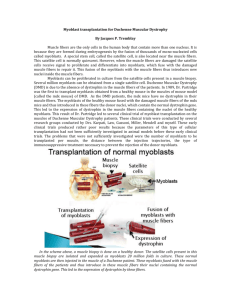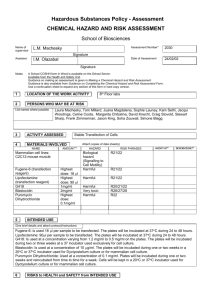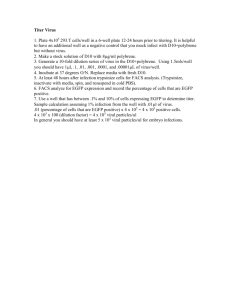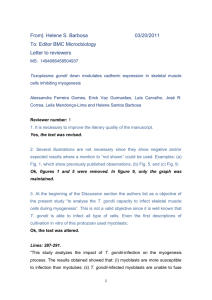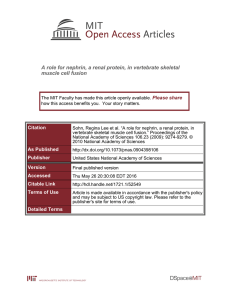Myoblast immortalisation
advertisement
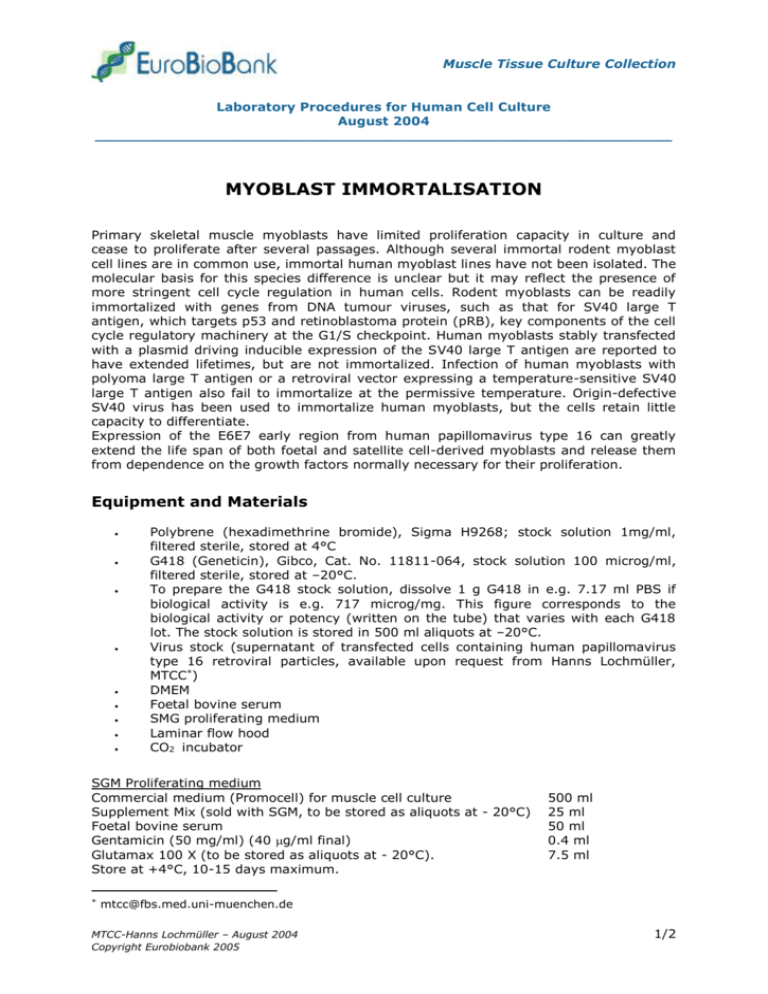
Muscle Tissue Culture Collection Laboratory Procedures for Human Cell Culture August 2004 _______________________________________________________________ MYOBLAST IMMORTALISATION Primary skeletal muscle myoblasts have limited proliferation capacity in culture and cease to proliferate after several passages. Although several immortal rodent myoblast cell lines are in common use, immortal human myoblast lines have not been isolated. The molecular basis for this species difference is unclear but it may reflect the presence of more stringent cell cycle regulation in human cells. Rodent myoblasts can be readily immortalized with genes from DNA tumour viruses, such as that for SV40 large T antigen, which targets p53 and retinoblastoma protein (pRB), key components of the cell cycle regulatory machinery at the G1/S checkpoint. Human myoblasts stably transfected with a plasmid driving inducible expression of the SV40 large T antigen are reported to have extended lifetimes, but are not immortalized. Infection of human myoblasts with polyoma large T antigen or a retroviral vector expressing a temperature-sensitive SV40 large T antigen also fail to immortalize at the permissive temperature. Origin-defective SV40 virus has been used to immortalize human myoblasts, but the cells retain little capacity to differentiate. Expression of the E6E7 early region from human papillomavirus type 16 can greatly extend the life span of both foetal and satellite cell-derived myoblasts and release them from dependence on the growth factors normally necessary for their proliferation. Equipment and Materials Polybrene (hexadimethrine bromide), Sigma H9268; stock solution 1mg/ml, filtered sterile, stored at 4°C G418 (Geneticin), Gibco, Cat. No. 11811-064, stock solution 100 microg/ml, filtered sterile, stored at –20°C. To prepare the G418 stock solution, dissolve 1 g G418 in e.g. 7.17 ml PBS if biological activity is e.g. 717 microg/mg. This figure corresponds to the biological activity or potency (written on the tube) that varies with each G418 lot. The stock solution is stored in 500 ml aliquots at –20°C. Virus stock (supernatant of transfected cells containing human papillomavirus type 16 retroviral particles, available upon request from Hanns Lochmüller, MTCC*) DMEM Foetal bovine serum SMG proliferating medium Laminar flow hood CO2 incubator SGM Proliferating medium Commercial medium (Promocell) for muscle cell culture Supplement Mix (sold with SGM, to be stored as aliquots at - 20°C) Foetal bovine serum Gentamicin (50 mg/ml) (40 g/ml final) Glutamax 100 X (to be stored as aliquots at - 20°C). Store at +4°C, 10-15 days maximum. * 500 ml 25 ml 50 ml 0.4 ml 7.5 ml mtcc@fbs.med.uni-muenchen.de MTCC-Hanns Lochmüller – August 2004 Copyright Eurobiobank 2005 1/2 Muscle Tissue Culture Collection Myoblast immortalisation ______________________________________________________________ Procedure For virus transfection start with a 100 mm plate containing myoblasts 30-50% confluent and an equivalent control plate for mock control without virus. Day 1: 1. Remove medium and add 1 ml of the virus stock plus 3 ml of serum-free medium containing 4 microg/ml polybrene. 2. Incubate at 37°C for 2 hours 3. Add 5 ml more medium with polybrene and continue incubating at 37°C for 5 more hours or till the end of the day. 4. Remove medium from cells, rinse once with medium, then feed cells with 10 ml of fresh medium without polybrene. Day 2: 1. Optional: At this point the cells can be divided onto several plates. It is useful to make a serie of dilutions if you want to end up with colonies that are well isolated. Day 3: Start G418 selection: 1. Remove medium and add medium containing G418 (e.g. 400 microg/ml). 2. Selection should be continued for 7 to 10 days. Days 5-12: 1. Change medium every other day; replace with medium containing G418 (e.g. 400 microg/ml). 2. Collect individual G418-resistant myoblast clones and expand them. 3. Cells in the mock control should not survive G418 treatment for longer than 7-10 days. Reference Lochmuller H, Johns T, Shoubridge EA. Expression of the E6 and E7 genes of human papillomavirus (HPV16) extends the life span of human myoblasts. Exp Cell Res. 1999, Apr 10;248(1):186-93. MTCC-Hanns Lochmüller – August 2004 Copyright Eurobiobank 2005 2/2
